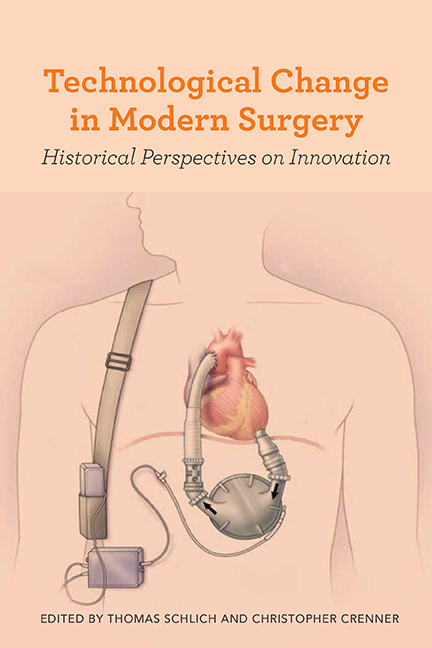Book contents
- Frontmatter
- Dedication
- Contents
- 1 Technological Change in Surgery: An Introductory Essay
- 2 Inimitable Innovation: Johann Friedrich Dieffenbach and the Renewal of Surgery, 1822–1847
- 3 Defining Difference: Competing Forms of Ovarian Surgery in the Nineteenth Century
- 4 “Making Bad Boys Good”: Brain Surgery and the Juvenile Court in Progressive Era America
- 5 Prosthetic Imaginaries: Spinal Surgery and Innovation from the Patient's Perspective
- 6 Disruptive Potential: The “Landmark” REMATCH Trial, Left Ventricular Assist Device (LVAD) Technology, and the Surgical Treatment of Heart Failure in the United States
- 7 Placebos and the Progress of Surgery
- 8 Surgical Practice and the Reconstruction of the Therapeutic Niche: The Case of Myocardial Revascularization
- Bibliography of Secondary Sources
- List of Contributors
- Index
2 - Inimitable Innovation: Johann Friedrich Dieffenbach and the Renewal of Surgery, 1822–1847
Published online by Cambridge University Press: 09 June 2021
- Frontmatter
- Dedication
- Contents
- 1 Technological Change in Surgery: An Introductory Essay
- 2 Inimitable Innovation: Johann Friedrich Dieffenbach and the Renewal of Surgery, 1822–1847
- 3 Defining Difference: Competing Forms of Ovarian Surgery in the Nineteenth Century
- 4 “Making Bad Boys Good”: Brain Surgery and the Juvenile Court in Progressive Era America
- 5 Prosthetic Imaginaries: Spinal Surgery and Innovation from the Patient's Perspective
- 6 Disruptive Potential: The “Landmark” REMATCH Trial, Left Ventricular Assist Device (LVAD) Technology, and the Surgical Treatment of Heart Failure in the United States
- 7 Placebos and the Progress of Surgery
- 8 Surgical Practice and the Reconstruction of the Therapeutic Niche: The Case of Myocardial Revascularization
- Bibliography of Secondary Sources
- List of Contributors
- Index
Summary
The surgeon Johann Friedrich Dieffenbach is often referred to as one of the most innovative characters in the development of German surgery during the early nineteenth century, particularly in the area of plastic surgery. But for a figure that has become almost emblematic of surgical innovation, Dieffenbach's case also challenges two common assumptions about innovation in surgery. One is that innovation in surgery during the nineteenth century was largely the product of technological change, particularly the introduction of anesthetic and aseptic techniques. The other, that a vital factor in the success of surgical innovations is the degree to which they can be reproduced and diffused. As for the first, Dieffenbach's work is located in the early part of the nineteenth century, rendering explanations of the growth of surgery based solely on technological determinism problematic, and opening up new questions about the driving forces behind innovation in surgery. With regard to the second, Dieffenbach's brand of innovation was formulated in a way that made it essentially inimitable. Dieffenbach's writings therefore provide an opportunity to reexamine these assumptions and offer alternative explanations.
The flourishing of plastic surgery in the early nineteenth century is a particular puzzle. Why would a technique dedicated to non-life-threatening conditions gain such momentum in the pre-anesthesia world? Many histories of plastic surgery avoid this question altogether and merely chart the diffusion of plastic surgical techniques, from the moment of the “rediscovery” of a technique for reconstructing the nose developed in India in the late eighteenth century, to the uptake of this and similar techniques by a number of surgeons in the German states and other countries in the early decades of the nineteenth century. More analytically oriented works have vaguely relied on a certain spirit of the age for answers. “Innovation was in the air,” writes Roy Porter about the introduction of a number of new plastic surgical techniques by the German surgeon Johann Friedrich Dieffenbach. Other authors have expressed surprise that plastic surgery boomed in spite of, not because of, the Zeitgeist. “The German enthusiasm for plastic surgery was a puzzling development,” observes David Hamilton, “because German-speaking thinkers were the origin of Naturphilosophie and the Romantic movement, whose antiscience stance rejected the scholarly achievements of Enlightenment thinking and substituted a free-floating theorizing and philosophical stance. Somehow,” he concludes, “plastic surgery, a fundamentally mechanistic human endeavor without the slightest hint of the mystical, flourished.”
- Type
- Chapter
- Information
- Technological Change in Modern SurgeryHistorical Perspectives on Innovation, pp. 21 - 50Publisher: Boydell & BrewerPrint publication year: 2017

